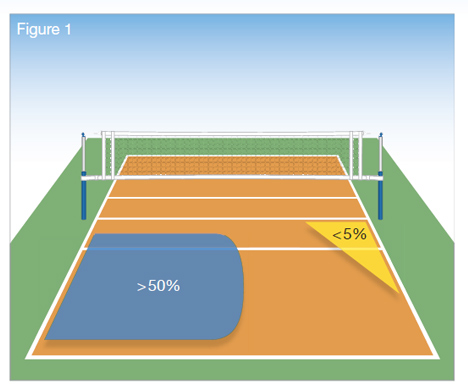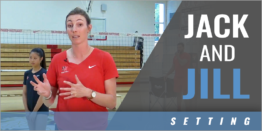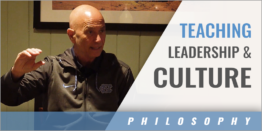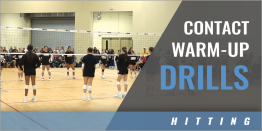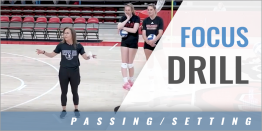|
By: Garrett Dolan, Ph.D., Social Scientist - Rice University Originally published in: Coaching Volleyball Magazine
HAVE YOU EVER been to a sporting event and were just amazed at an athlete's ability to react to a situation under extreme time constraints? The soccer goalie's ability to block a penalty kick, the tennis player's ability to return a serve, or the volleyball player digging what appeared to be an non-returnable kill-shot. While these athletes may not be the fastest or strongest players on the court, they have a seemingly uncanny ability to anticipate an opponent's actions. They appear to have a better understanding than most where the ball will be. How do they do it? Is it luck or something that can be learned, and thus, taught? LEARNING TO READ Learning to "read" in volleyball is not about comprehension or fluency. Instead, it is about developing the ability to recognize certain patterns of behaviors so you can react with greater speed and accuracy. Many of us who played competitive sports have experienced situations when we knew where the next pass was going, or who the player was going to be to get the last-second shot at the basket. Surely, you have heard a coach yelling from the sidelines for his team to react to an emerging scenario because he "could see the play developing." This ability to see patterns, to process visual cues and anticipate a future response, is called pattern recognition and recall (PRR). PRR skills have been documented in the scientific literature for years. The Australian Sports Commission (2002)found a positive correlation between the ability to recognize patterns and game- based decision-making skills. As recently as 2009, the Journal of Vision, published by the Association for Research in Vision and Ophthalmology, released a study about soccer goalies and how they learned to better anticipate the action of others within the context of a penalty kick. In volleyball, pro athlete and Director, Membership Development & Disabled Programs for USA Volleyball, John Kessel, has written on the significance of reading stating " ... reading ... is the most important skill in volleyball." He contends that in order to raise the nation's overall competitiveness on the international stage, coaches need to develop practice regimes where anticipatory play is at the core. No longer should coaches focus their energy at the point when a player contacts the ball. A concerted effort must be made to teach players about the conditions that led up to a player's contact. Simply stated, the better a player is at anticipating the game that's developing, the better they will be at predicting what is going to happen next and physically readying herself to make a play. Reading and anticipating allows the player to have more time to make an accurate judgment. K-12th grade athletes come in all shapes, sizes and skill levels. So, it should be no surprise that some players can read a scenario more naturally than others. This is not to say they are a better or worse athlete, just that there is a range of natural skills. Fortunately, developing PRR is a learnable skill. The challenge however, is that most young athletes' brains are still developing and might not be capable of understanding such information. Only recently have neuroscientists begun to understand why pre-adults (teenagers) have limited capability to read a developing situation. It appears that the ability to anticipate, interpret feedback, and see the relationship among disparate behaviors within the context of a chain of events is a higher order brain function. Teenagers' brains have less myelin (white matter) in the frontal lobes than adults, and as a result, are unable to transmit the requisite amount of nerve signals that foresight skills require. This will change as teens become adults, but it does leave a special educational burden on high school coaches. If we truly want to meet Mr. Kessel's call for stronger pools of players, our elementary, high school and club level coaches will need to patiently, deliberately and repeatedly practice the skills required for foresight to be commonplace. LEADING TO LEARN Teaching athletes to see a play develop is both challenging and easy. It is difficult for the coach because they often have to interrupt the regular flow of practice to create teachable moments, yet maintain a practice environment that emulates the time constrained situations game play demands. Complicating the matter is if the coach is uncomfortable or unsure of the subject and related teaching methods. Nevertheless, the coach's leadership is required for the team to assimilate reading skills. Teaching PRR is no different than any other skill development activity (i.e. serving, passing etc.). If a team really wants to elevate their performance and learn to read patterns, it is absolutely essential for the coach to lead the players through the transition. On the other hand, the tools necessary to teach pattern recognition are readily available to all coaches. They don't necessarily have to cost any money or require any new equipment. With a little creative thinking, any program can set up a training regime to work on pattern recognition. BRING YOUR BRAIN TO PRACTICE PRR is an acquired skill. At its most fundamental level, the ability to read developing plays requires a heightened level of awareness for what is going on around the ball while it is on the other side of the court – not at the point of contact or when the ball is on your side of the net. When the hitter is attacking, the defense should already be moving towards an optimum cover position and be in place as the strike occurs. The time demands to accomplish this are measured in fractions of a second; thus to be good at anticipatory play, athletes need to consciously work to develop a procedural memory (i.e. like muscle memory) without the need for conscious control or attention. In other words, athletes need to teach their bodies to read and react on a subconscious level to ensure the fastest results. Failure to do so handicaps the defense's reaction time. Fortunately, with a little practice, players can develop a library of techniques to read plays. A powerful way to think about teaching these skills is to create a conceptual framework to help athletes group different techniques by time of occurrence. This is a useful approach for situations when speedy recall is needed because it minimizes the number and degree of factors that may confound an athlete. Also, a framework acts like a map that gives coherence to the multitude of options available. 1. Pre-Game – study the past
Ideally, each team should have statistics about their opponents to help them guide their strategy. However, if for some reason that is not possible, there are some broad generalizations that can be quite insightful. A good rule-of-thumb is for outside hitters to receive between 50-60 percent of all sets, with the middle and right side hitters splitting the difference. This is very powerful information because it tells you which position will be sending the ball over the net (i.e. outside hitters 50-60 percent of the time). Blockers now have a critical piece of in-formation to guide their efforts. Based on an analysis of NCAA 2009 Volleyball Statistics for 617 Divisions I-III schools (as of 12/09), the average number of kills per game is 12.1 with a "hitting percentage (kills – errors/at-tempts)" of 20.4 percent. When these two variables are analyzed together, it tells you that on average, university teams make 53 attempts at scoring. When this is combined with the information about setters' tendencies to pass to a certain position, defenses can better anticipate who will be hitting the ball and how well they will do on average. This gives the coach strategic insight and the option of making some defensive adjustments accordingly.
2. During the game–watching the present The athlete that is present "in the moment" can derive a lot of information about an opponent. In poker, for example, when a player is about to take an action and has a detectable change in behavior like a twitch or fidget it is called a "tell." A "tell" can inform you about the player's state of mind and what the player is about to do. In volleyball, players can pick up auditory and visual performance cues (i.e. tells) to indicate what will occur next. Common cues include:
3. Post-Game - thinking forward Good "readers" are able to catalog cues and statistical information in their subconscious and then quickly tap that information during games. The speed of play often doesn't allow for athletes to consciously breakdown a play, think about what their opponent is doing, and then predict the right reaction. All of this work needs to happen on an unconscious level. The ability to recall and react is directly related to the athlete's ability to catalog information. In competitive sports it is important to look backwards before going forward. The ability to do PRR requires practice and repetition for successful adoption. Coaches that are concerned with educating their players understand this and will use game results to reinforce training principles. Three proven methods for teaching after a game include:
SUMMARY Pattern recognition and recall skills have proven to be effective in many sports. However, in volleyball there does not appear to be a widespread adoption of training regimes where anticipatory play is at the core. In order to bolster the nation's overall competitiveness on the international stage, prominent experts are calling for that to change. Teaching reading skills to players may seem daunting at first because most coaches and players were not exposed to it when they were at the same age. Fortunately, with some patient and deliberate efforts, players can be taught to quickly grasp these skills. Acknowledgement: I would like to thank John Kessel, Director, Membership Development & Disabled Programs for USA Volleyball, for his advice and encouragement with writing this article. Endnotes: The Teen Brain: It's Just Not Grown Up Yet, National Public Radio, March 2010. Treatment of Psychiatric Symptoms Associated With a Frontal Lobe Tumor Through Surgical Resection, The American Journal Of Psychiatry, June 2007. Transfer of Pattern Recall Skills May Contribute to the Development of Sport Expertise, Journal of Applied Cognitive Psychology, April 2005.
|




